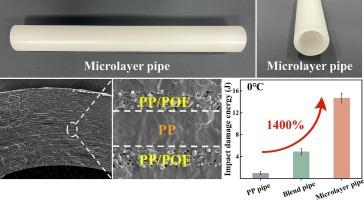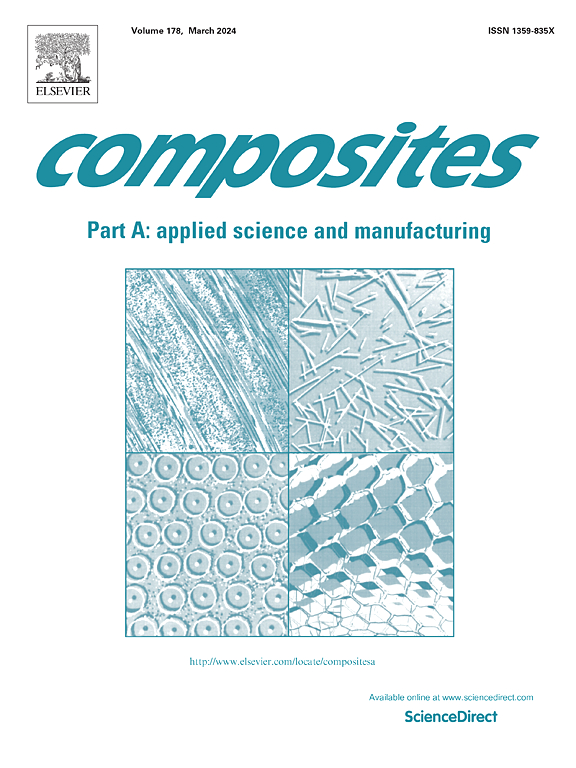Achieving superior low-temperature mechanical performances by nacre-like alternating microlayered structures in PP/POE-based pipes
IF 8.1
2区 材料科学
Q1 ENGINEERING, MANUFACTURING
Composites Part A: Applied Science and Manufacturing
Pub Date : 2024-11-19
DOI:10.1016/j.compositesa.2024.108598
引用次数: 0
Abstract
The poor low-temperature mechanical performance significantly constrains the use of polypropylene (PP) pipe in frigid climates. Here, the PP/POE-based pipes were successfully manufactured using an independently-developed microlayer pipe coextrusion technology, including 8-, 32–, 128-, and 512-layer. The low-temperature mechanical performance of the 512-layer pipe is significantly improved, compared with the blend pipe, its drop hammer impact damage energy and axial tensile breaking energy are increased by 200% and 1100%, respectively. The results from DSC, WAXD, and SAXS indicate that all the microlayer pipes and the blend pipe have almost the same crystal structure. Therefore, the unparalleled low-temperature mechanical performance is attributable to the ultrathin microlayer structures, which dissipated energy by morphological variation of the dispersed phase POE and the effective initiation and termination of craze. Briefly, the self-developed microlayer pipe coextrusion technology provides an effective strategy for the preparation of low-temperature mechanical performance robust PP pipe, and provides a simple and universal method for building an ideal polymer pipe material.

在基于 PP/POE 的管道中采用珍珠层状交替微层状结构实现卓越的低温机械性能
聚丙烯(PP)管材低温机械性能差,极大地限制了其在寒冷气候条件下的使用。本文采用自主研发的微层管共挤技术,成功制造出基于聚丙烯/聚乙烯的管材,包括 8 层、32 层、128 层和 512 层。与混合管材相比,512层管材的低温力学性能显著提高,其落锤冲击破坏能和轴向拉伸断裂能分别提高了200%和1100%。DSC、WAXD 和 SAXS 的结果表明,所有微层管和混合管的晶体结构几乎相同。因此,无与伦比的低温机械性能归功于超薄微层结构,它通过分散相 POE 的形态变化和裂纹的有效引发和终止来耗散能量。简而言之,自主研发的微层共挤管材技术为制备低温力学性能优异的聚丙烯管材提供了有效策略,为构建理想的聚合物管材材料提供了一种简单而通用的方法。
本文章由计算机程序翻译,如有差异,请以英文原文为准。
求助全文
约1分钟内获得全文
求助全文
来源期刊

Composites Part A: Applied Science and Manufacturing
工程技术-材料科学:复合
CiteScore
15.20
自引率
5.70%
发文量
492
审稿时长
30 days
期刊介绍:
Composites Part A: Applied Science and Manufacturing is a comprehensive journal that publishes original research papers, review articles, case studies, short communications, and letters covering various aspects of composite materials science and technology. This includes fibrous and particulate reinforcements in polymeric, metallic, and ceramic matrices, as well as 'natural' composites like wood and biological materials. The journal addresses topics such as properties, design, and manufacture of reinforcing fibers and particles, novel architectures and concepts, multifunctional composites, advancements in fabrication and processing, manufacturing science, process modeling, experimental mechanics, microstructural characterization, interfaces, prediction and measurement of mechanical, physical, and chemical behavior, and performance in service. Additionally, articles on economic and commercial aspects, design, and case studies are welcomed. All submissions undergo rigorous peer review to ensure they contribute significantly and innovatively, maintaining high standards for content and presentation. The editorial team aims to expedite the review process for prompt publication.
 求助内容:
求助内容: 应助结果提醒方式:
应助结果提醒方式:


